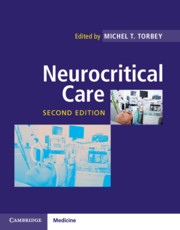Book contents
- Neurocritical Care
- Neurocritical Care
- Copyright page
- Contents
- Contributors
- Preface
- Chapter 1 The Neurological Assessment of the Critically Ill Patient
- Chapter 2 Cerebral Blood Flow Physiology and Metabolism in the Neurocritical Care Unit
- Chapter 3 Cerebral Edema and Intracranial Pressure in the Neurocritical Care Unit
- Chapter 4 Hypothermia in the Neurocritical Care Unit: Physiology and Applications
- Chapter 5 Analgesia, Sedation, and Paralysis in the Neurocritical Care Unit
- Chapter 6 Airway Management and Mechanical Ventilation in the Neurocritical Care Unit
- Chapter 7 Neuropharmacology in the Neurocritical Care Unit
- Chapter 8 Intracranial Monitoring in the Neurocritical Care Unit
- Chapter 9 Electrophysiologic Monitoring in the Neurocritical Care Unit
- Chapter 10 The Role of Transcranial Doppler as a Monitoring Tool in the Neurocritical Care Unit
- Chapter 11 Ischemic Stroke in the Neurocritical Care Unit
- Chapter 12 Intracerebral Hemorrhage in the Neurocritical Care Unit
- Chapter 13 Management of Cerebral Venous Thrombosis in the Neurocritical Care Unit
- Chapter 14 Subarachnoid Hemorrhage in the Neurocritical Care Unit
- Chapter 15 Status Epilepticus in the Neurocritical Care Unit
- Chapter 16 Neuromuscular Disorders in the Neurocritical Care Unit
- Chapter 17 Management of Head Trauma in the Neurocritical Care Unit
- Chapter 18 Management of Autoimmune Encephalitis in the Neurocritical Care Unit
- Chapter 19 Management of Cerebral Salt-Wasting Syndrome and Syndrome of Inappropriate Antidiuresis in the Neurocritical Care Unit
- Chapter 20 Brain Death in the Neurocritical Care Unit
- Chapter 21 Neuroterrorism and Drug Overdose in the Neurocritical Care Unit
- Chapter 22 Infections of the Central Nervous System in the Neurocritical Care Unit
- Chapter 23 Management of the Spinal Cord Injury in the Neurocritical Care Unit
- Chapter 24 Postoperative Management in the Neurocritical Care Unit
- Chapter 25 Ethical Considerations in the Neurocritical Care Unit
- Chapter 26 Pulmonary Consult: Management of Severe Hypoxia in the Neurocritical Care Unit
- Chapter 27 Management of Refractory Arrhythmias in the Neurocritical Care Unit
- Chapter 28 An Infectious Diseases Consult in the Neurocritical Care Unit
- Chapter 29 A Nephrology Consult in the Neurocritical Care Unit
- Chapter 30 Management of Hepatic Encephalopathy in the Neurocritical Care Unit
- Chapter 31 Hypoxic Encephalopathy in the Neurocritical Care Unit
- Chapter 32 Management of Delirium in the Neurocritical Care Unit
- Chapter 33 Generalized Weakness in the Neurocritical Care Unit
- Chapter 34 Management of Severely Brain-Injured Patients Recovering from Coma in the Neurocritical Care Unit
- Chapter 35 Acute Demyelinating Disorders in the Neurocritical Care Unit
- Chapter 36 Building a Case for a Neurocritical Care Unit
- Chapter 37 Neurointensive (NCCU) Care Business Planning
- Index
- References
Chapter 16 - Neuromuscular Disorders in the Neurocritical Care Unit
Published online by Cambridge University Press: 24 July 2019
- Neurocritical Care
- Neurocritical Care
- Copyright page
- Contents
- Contributors
- Preface
- Chapter 1 The Neurological Assessment of the Critically Ill Patient
- Chapter 2 Cerebral Blood Flow Physiology and Metabolism in the Neurocritical Care Unit
- Chapter 3 Cerebral Edema and Intracranial Pressure in the Neurocritical Care Unit
- Chapter 4 Hypothermia in the Neurocritical Care Unit: Physiology and Applications
- Chapter 5 Analgesia, Sedation, and Paralysis in the Neurocritical Care Unit
- Chapter 6 Airway Management and Mechanical Ventilation in the Neurocritical Care Unit
- Chapter 7 Neuropharmacology in the Neurocritical Care Unit
- Chapter 8 Intracranial Monitoring in the Neurocritical Care Unit
- Chapter 9 Electrophysiologic Monitoring in the Neurocritical Care Unit
- Chapter 10 The Role of Transcranial Doppler as a Monitoring Tool in the Neurocritical Care Unit
- Chapter 11 Ischemic Stroke in the Neurocritical Care Unit
- Chapter 12 Intracerebral Hemorrhage in the Neurocritical Care Unit
- Chapter 13 Management of Cerebral Venous Thrombosis in the Neurocritical Care Unit
- Chapter 14 Subarachnoid Hemorrhage in the Neurocritical Care Unit
- Chapter 15 Status Epilepticus in the Neurocritical Care Unit
- Chapter 16 Neuromuscular Disorders in the Neurocritical Care Unit
- Chapter 17 Management of Head Trauma in the Neurocritical Care Unit
- Chapter 18 Management of Autoimmune Encephalitis in the Neurocritical Care Unit
- Chapter 19 Management of Cerebral Salt-Wasting Syndrome and Syndrome of Inappropriate Antidiuresis in the Neurocritical Care Unit
- Chapter 20 Brain Death in the Neurocritical Care Unit
- Chapter 21 Neuroterrorism and Drug Overdose in the Neurocritical Care Unit
- Chapter 22 Infections of the Central Nervous System in the Neurocritical Care Unit
- Chapter 23 Management of the Spinal Cord Injury in the Neurocritical Care Unit
- Chapter 24 Postoperative Management in the Neurocritical Care Unit
- Chapter 25 Ethical Considerations in the Neurocritical Care Unit
- Chapter 26 Pulmonary Consult: Management of Severe Hypoxia in the Neurocritical Care Unit
- Chapter 27 Management of Refractory Arrhythmias in the Neurocritical Care Unit
- Chapter 28 An Infectious Diseases Consult in the Neurocritical Care Unit
- Chapter 29 A Nephrology Consult in the Neurocritical Care Unit
- Chapter 30 Management of Hepatic Encephalopathy in the Neurocritical Care Unit
- Chapter 31 Hypoxic Encephalopathy in the Neurocritical Care Unit
- Chapter 32 Management of Delirium in the Neurocritical Care Unit
- Chapter 33 Generalized Weakness in the Neurocritical Care Unit
- Chapter 34 Management of Severely Brain-Injured Patients Recovering from Coma in the Neurocritical Care Unit
- Chapter 35 Acute Demyelinating Disorders in the Neurocritical Care Unit
- Chapter 36 Building a Case for a Neurocritical Care Unit
- Chapter 37 Neurointensive (NCCU) Care Business Planning
- Index
- References
Summary
Neuromuscular diseases and respiratory failure are common problems encountered in both neurologic and medical intensive care units. Neuromuscular respiratory failure can be caused by diseases of the motor neuron, peripheral nerve, neuromuscular junction, or muscle. Thus, localization of the disorder is essential for adequate management.
- Type
- Chapter
- Information
- Neurocritical Care , pp. 188 - 198Publisher: Cambridge University PressPrint publication year: 2019



